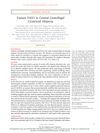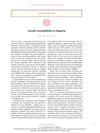Deciphering the Pathogenesis of Central Centrifugal Cicatricial Alopecia
September 2019
in “
Journal of Investigative Dermatology
”
TLDR CCCA in women of African ancestry may be caused by PADI3 gene mutations and intense hair grooming.
Central centrifugal cicatricial alopecia (CCCA) was identified as the most common form of scarring alopecia among women of African ancestry, with a prevalence of 2.7%-5.6%. The study aimed to identify genetic risk variants for CCCA and used whole exome sequencing on 16 patients, discovering one splice site and three missense heterozygous mutations in the PADI3 gene. These mutations were predicted to be pathogenic, affecting protein folding and resulting in reduced PADI3 expression and decreased enzymatic activity. Further analysis in a replication set of 42 patients showed pathogenic variants in 24% of CCCA patients. The study concluded that intense hair grooming habits, combined with PADI3 mutations, which are crucial for hair shaft formation, may lead to CCCA.



